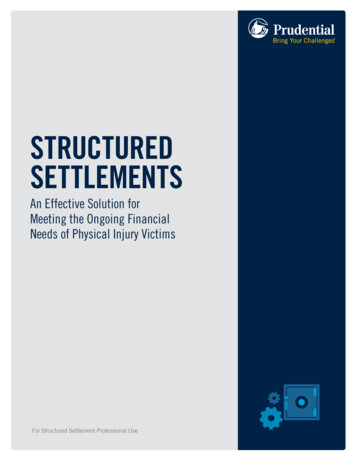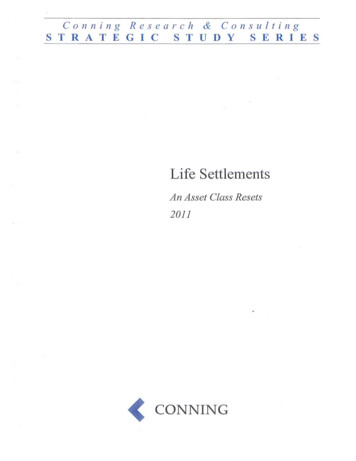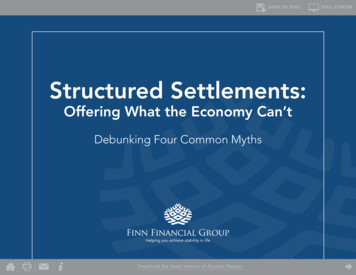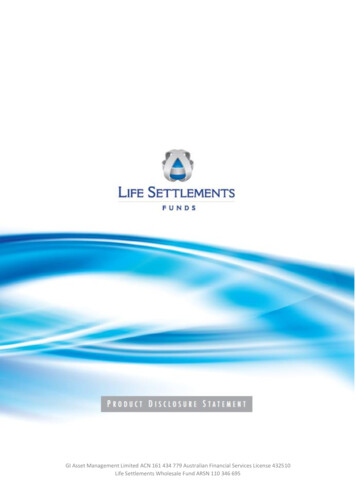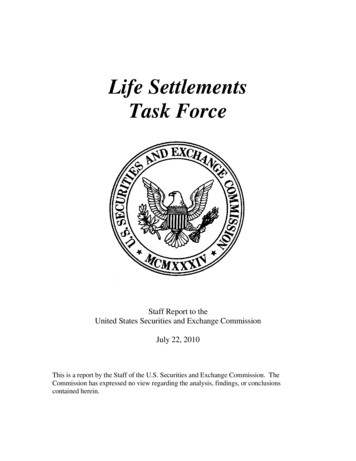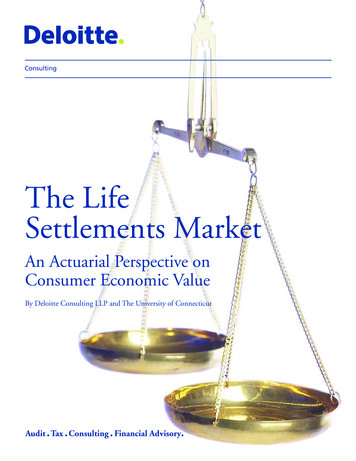
Transcription
ConsultingThe LifeSettlements MarketAn Actuarial Perspective onConsumer Economic ValueBy Deloitte Consulting LLP and The University of ConnecticutAudit . Tax . Consulting . Financial Advisory.
Table of ContentsPreface . 1Executive Summary . 1Introduction and Background . 3Perceived Benefits of Life Settlements . 3Actuarial Valuation . 4Finance Theory Approach . 6Empirical Analysis . 7Marketing Materials and Solicitations . 10Regulations and Disclosures . 10Limitations of Current Regulations and Disclosure Requirements . 11Perceived Benefits of Life Settlements Revisited . 11Misconceptions on Lapse Experience, Pricing Techniques,and Profitability of Life Insurance Companies . 12Conclusion . 13Acknowledgments . 14Bibliography . 15
PrefaceExecutive SummaryThis joint study was conducted by Deloitte Consulting LLP and theUniversity of Connecticut (UConn) through the Deloitte - UConnActuarial Center (the Center). The Center is a collaborativearrangement between UConn and Deloitte Consulting whoseobjectives include:In this study, we have conducted a comprehensive actuarial analysisof the Life Settlements industry. This enables us to better quantifythe value provided by the sale of a life insurance policy to a LifeSettlements company, relative to other options available to apolicyholder. Current literature focuses on comparing only twooptions: the Life Settlements Value (LSV) and the Cash SurrenderValue (CSV) of a life insurance policy. In our study, we havequantified the value of a third option: retaining the policy untildeath. We refer to the value of this third option as the IntrinsicEconomic Value (IEV). Our study has focused on comparing the IEVwith the LSV. The difference between the IEV and LSV is referred toas the Lost Economic Value (LEV). Integrating the academic resources at UConn with the deepindustry knowledge of Deloitte Consulting Developing more effective approaches in insurance education,training, applied research, and risk managementThe study was conducted under the direction of Jay Vadiveloo,Professor and Director of the Center and a Senior Manager withDeloitte Consulting. This study utilized faculty and students from theDepartments of Actuarial Science and Finance at UConn and keyprofessionals from Deloitte Consulting. The study reflects ourintegrated approach to applied actuarial research by ensuring thatevery assertion and analysis meets all professional and academicstandards, and focuses on real life issues raised by the LifeSettlements industry.We conducted three types of analyses to compare the IEV with theLSV:1. An actuarial valuation and probabilistic analysis2. An analysis from a finance theory perspective3. An empirical analysis using data from actual filings of LifeSettlements contracts with the New York Department ofInsuranceThe results of our analyses show the following: For all issue ages, varying attained ages of policy sale, andvarying levels of impairment, the actuarial valuation shows thatthe IEV always exceeds the LSV. The actuarial valuation capturesonly the first year commissions, taxes, and the hurdle rate indetermining the LSV. The IEV ranges from 113 percent to 165percent of the LSV for the selected examples in our analysis. Ouranalysis also indicates it is highly probable that the realized IEVwhen the policyholder dies will exceed the LSV. The finance theory approach reinforces the conclusions of theactuarial valuation. This analysis demonstrates that the yieldfrom a life insurance policy of an impaired policyholder that ismaintained until death is likely to exceed any return realized byinvesting the Life Settlements proceeds in a variety ofinvestment options. The empirical analysis shows that for all Life Settlements sales incalendar years 2000 through 2003, Life Settlements companiespaid an average of 20 cents per dollar of face amount ofinsurance, while the IEV averaged 64 cents on the dollar. Interms of benefits paid, the Life Settlements companies paid outonly 45.7 million in benefits while the IEV was 143.2 million,resulting in a LEV of 98.5 million. The results were similar forthe empirical analysis of all Life Settlements deaths in calendaryears 2000 through 2003. The empirical analysis shows asignificantly wider disparity between the IEV and LSV ascompared to the actuarial valuation. This is attributable to othernonstandard transaction costs such as provider’s originationfees, servicing fees, financial underwriter fees, etc., that areignored in the actuarial valuation.Copyright 2005 Deloitte Development LLC. All rights reserved.1
Further research into the LEV generated from a Life Settlements saleshows that it arises from the high transaction costs involved in thesale. The risk profit component (i.e. the pure profit earned in theabsence of any transaction costs) represents only 30 percent of theLEV. The remaining 70 percent represents transaction costs in theform of expenses, commissions, taxes, and the expense profitcomponent (i.e. profit that Life Settlements companies require ascompensation for financing the up-front transaction costs). Thesecombined profit and transaction costs represent between 50 percentto 67 percent of the Intrinsic Economic Value of the insurancecontract. Relative to other asset transaction costs, including illiquidassets such as Art that incur costs only in the 10 percent to 15percent range, Life Settlements transaction costs are significantlyhigher.The study includes an extensive Web site review of marketingmaterials and solicitations of Life Settlements companies to analyzethe common assertion made by the Life Settlements industry that ittargets senior citizens who are already planning to lapse or surrendertheir life insurance contract. It is clear from our review that the LifeSettlements industry is targeting a larger market than this selectgroup of policyholders. These marketing materials offer multiplereasons, other than lapse avoidance, to encourage a policyholderwith impaired health to sell a life insurance policy.Our study analyzes current proposed regulations and disclosurerequirements for Life Settlements companies. Based on our research,the study discusses limitations of these current regulations inproviding appropriate disclosure requirements of Life Settlementstransactions and in ensuring that Life Settlements agents have thenecessary specialized training to provide proper financial advice topolicyholders.Our study also analyzes from an actuarial perspective, severalassertions made in current Life Settlements literature regardingexperience lapse rates of life insurance companies, pricingtechniques, and the policyholder profile of lapsed contracts. Awidely quoted common misconception is that less than 12 percent ofuniversal life contracts actually pay a death benefit and roughly 88percent lapse or surrender their contract.1 This reinforces theassertion made by the Life Settlements industry that it targets seniorcitizens who are planning to lapse or surrender their contract in thefirst place. Based on the fact that policyholders in the target marketof the Life Settlements industry tend to exhibit ultimate lapseexperience of life insurance companies, our analysis shows that morethan 65 percent of this segment receives a death benefit. This 65percent includes policyholders with impaired health who arecurrently being targeted by the Life Settlements Industry.2Copyright 2005 Deloitte Development LLC. All rights reserved.Our study clarifies one of the generally established actuarialprinciples of life insurance pricing: healthy lives tend to lapse andunhealthy lives tend to persist. Hence, a Life Settlements transactionthat results in the persistency of an impaired policyholder hasminimal impact on the anticipated profitability of a life insurancecontract. While there may not be a material financial impact, lifeinsurance companies are concerned that policyholders may notreceive complete information from properly trained agents on thesuitability of a Life Settlements transaction.The study concludes with an analysis of the study’s impact onpolicyholders in the Life Settlements target market, beneficiaries oflife insurance policies, financial advisors, insurance regulators, andthe future of the Life Settlements industry. The policyholder withimpaired health could maximize her estate value if other assets areliquidated and the life insurance policy is maintained until death. Abeneficiary who assists an impaired policyholder in maintaining herlife insurance contract will experience a return on investment that islikely to exceed any other investment option. Our study can lead toenhanced regulations and disclosure requirements that will benefitfinancial advisors by helping them better educate the policyholderconcerning the benefits or consequences of selling her life insurancepolicy. Because our analysis shows that for the majority ofpolicyholders with impaired health, the greatest economic valueresults from retaining the contract until death, it is likely that thetarget market that could truly benefit from the Life Settlementsindustry is significantly smaller than currently perceived. The lifeinsurance industry, however, is well positioned to create a moreefficient secondary market for impaired policyholders similar toaccelerated death benefits for Viaticals or a loan to the policyholderusing the face amount of the policy as collateral.
Introduction and BackgroundPerceived Benefits of Life SettlementsThe Life Settlements industry evolved in the late 1990s as anextension of the Viatical industry. According to a Conning study,both Life Settlements and Viaticals refer to “the transfer of anexisting life insurance policy under circumstances where the insuredhas an impaired life expectancy”.2 The different characteristicsbetween Viaticals and Life Settlements are summarized in Exhibit 1:The Wharton study5 describes the following benefits offered by theLife Settlements industry to a policyholder and society as a whole:Exhibit 1: Viaticals versus Life Settlements3ViaticalsLife Settlements 100,000 andusually between 25,000- 50,000 100,000 andusually over 250,000PolicyholderAIDS patients in the25-44 age bandSenior citizensover age 65Life Expectancies 2 years and usually12 months or less 2 years and ashigh as 12-15 yearsPolicy SizeThe Viatical industry has faced challenges from medicalbreakthroughs in the diagnosis and treatment of HIV/AIDS, whichadds to the uncertainty of predicting life expectancies of terminally illpolicyholders. In addition, the life insurance industry has respondedto the need for liquidity by terminally ill policyholders by offeringaccelerated death benefits in their policies.1. Introduces an organized secondary market for life insurancethat otherwise would have been available only informally orfrom life insurance companies through surrender of a lifeinsurance policy.2. Provides liquidity to an insurance contract that is a relativelyilliquid asset. This could increase the value of a life insurancecontract in the primary market as well.3. Offers significantly higher resale values in the secondary marketfor policies of people with impaired lives, compared to the cashsurrender values of the policies. This is because cash surrendervalues are fixed by regulation and cannot be conditioned onhealth impairment.4. Establishes an efficient secondary market in the financialservices industry that could improve the economic welfare ofconsumers in general, as well as the value of the correspondingasset in the primary market.On the other hand, the Life Settlements industry has developed amore organized insurance resale market by focusing on the purchaseof life insurance policies in the over age 65 market with impairedmortality, but not terminally ill. It focuses on large face amountpolicies where transaction and administrative costs can be moreeffectively spread out and managed.The growth rates reported by the Life Settlements industry aresignificant. The Conning study estimates that Life Settlementstransactions in 2002 approximated 2 billion in face amount ofinsurance, which reflects a 19 percent compound growth rate since1998. As a reflection of the potential market for Life Settlements,the Wharton study4 estimates the total value of life insurance policiesheld by senior citizens with impaired mortality to be as large as 100billion.Copyright 2005 Deloitte Development LLC. All rights reserved.3
Actuarial ValuationExhibit 3The actuarial valuation of the Life Settlements industry expands onthe work done in previous studies that focused on comparisonsbetween the value offered by a Life Settlements company and thevalue obtained from a life insurance company if the contract issurrendered. Our research recognizes three options available to apolicyholder with impaired mortality:Intrinsic Economic ValueLife Settlements ValueDetermined at settlementDetermined at settlementBased on impaired mortalityat settlementBased on impaired mortality atsettlement, possibly with marginsfor conservatism1. The policyholder could surrender her contract to the lifeinsurance company that issued the policyUses risk-free interest ratediscountingUses Life Settlements companyhurdle rate2. The policyholder could sell her contract in the secondary marketto a Life Settlements companyNo transaction costsRecognizes impact ofunderwriting, reinsurance,commissions, expenses, taxes, etc.3. The policyholder could choose to retain her contract until deathThe third option has never been analyzed or quantified in previousstudies and this is the main thrust of this section of our research. Wehave used an actuarial perspective to quantify the value to thepolicyholder if she chooses to retain her contract until death. We callthis value the Intrinsic Economic Value (IEV) and it is measuredprospectively as:IEV APV of Future Death Benefits – APV of Future Premiumswhere APV is the Actuarial Present ValueThe Actuarial Present Value (APV), which discounts values using bothinterest and survivorship, uses the impaired mortality of thepolicyholder for survivorship and the risk-free interest rate for thechoice of interest rate. A risk-free interest rate is appropriatebecause for most insurance products, the cash flows are known withcertainty and do not fluctuate with the general economic cycle.A related definition is the Lost Economic Value (LEV) that looks at thedifference between the IEV and the Life Settlements Value (LSV).This is a measure of the value given up (or lost) by a policyholderwho chooses to sell her insurance contract to a Life Settlementscompany instead of retaining it. As part of our research, we willanalyze the various components that make up the LEV.Before we describe the actuarial formulas needed to calculate the IEVand LSV, we will perform a qualitative analysis of some of thedifferences (and similarities) between these three measures of valueof a life insurance contract – the Cash Surrender Value (CSV), theLSV, and the IEV. Exhibits 2 and 3 summarize these differences:Exhibit 2Cash Surrender ValueLife Settlements ValueDetermined at issueDetermined at settlementBased on fully underwritten,standard mortalityBased on impaired mortality atsettlement, possibly with marginsfor conservatismValues set by regulationValues set by Life SettlementscompanyValues do not change whenthe health status changes4Values vary depending on the levelof impairment of the policyholderCopyright 2005 Deloitte Development LLC. All rights reserved.To develop the actuarial model needed to calculate these threemeasures of value of a life insurance contract, we made thefollowing assumptions:1. The life insurance contract is a whole life insurance policy withlevel premiums payable for life.2. The risk-free rate used to determine the IEV equals 5 percent.3. The CSV equals the net level premium reserve based on the1980 Commissioner’s Standard Ordinary (CSO) mortality tableand a 5 percent interest rate.4. Impaired mortality for determining the LSV and IEV are based onmortality rates that are a factor (e.g. 5, 10, 15, 20) multiplied bythe industry 75 – 80 Basic Mortality Table.5. The annual gross premium is approximated by a 20 percentloading on the annual net premium calculated using the 1980CSO mortality and a 5 percent interest rate.6. Transaction costs included in determining the LSV are first yearcommissions of 4 percent of the face amount, 35 percent taxrate on death benefit net proceeds, and 8 percent interest ratefor discounting cash flows. Other non-standard transactioncosts such as provider’s origination fees, servicing fees, financialunderwriter fees, etc., are ignored in this analysis.The actuarial formulas used in our calculation are shown below. Allcalculations are based on 1 of face amount, issue age y, and currentage x. An asterisk (*) on a symbol denotes that impaired mortalitywas used.Py Valuation Premium Ay/äywhere Ay Net Single Premium at age y for 1 face amount ofinsuranceäy Net Single Premium for a 1 life annuity due to y basedon the 1980 CSO mortality table and a 5 percent interest rateCSVx Ax – PyäxIEVx A*x – 1.2Pyä*xwhere 1.2Py reflects a 20 percent loading for expenses and therisk-free rate of 5 percent is used for discounting
To calculate the LSV, we first calculate the tax expense to the LifeSettlements company incurred at death of the policyholder. Weassume that death occurs at the end of the impaired life expectancy.Exhibit 6: Probability That IEV Exceeds LSVIssue Age: 45 YearsTax 0.35(1 – 0.04 – LSVx – e*x (1.2)Py)Attained Age The 0.04 reflects the 4 percent of face amount that is theassumed commission for Life Settlements contracts is the expected future lifetime for a life age x 35 percent is the standard corporate tax rateImpairment Level 10 Impairment Level 0%Then4. As the issue age of the policyholder increases, both the ratio ofLSV to CSV and IEV to LSV increases for the same level ofimpairment and attained age at policy surrender/sale.LSVx (1 – Tax) A*x – 1.2Py ä*x – 0.04where the hurdle rate of 8 percent is used for discountingNote that LSV appears in the equation for Tax, so the final equationneeds to be solved for LSV. This produces the formula:Another useful statistic is the probability that the realized IEV exceedsthe LSV when the policyholder dies. This analysis recognizes that theLSV is realized immediately at sale of the contract to the LifeSettlements company, while the IEV is an expected value of possiblerealizations of the economic value of the life insurance contractdepending on when the policyholder dies. For instance, if thepolicyholder retains a contract and survives beyond some period, therealized IEV will become less than the LSV. Because we cannotpredict when a policyholder will die with certainty, we calculate theprobability that a policyholder will die within a period during whichthe realized IEV exceeds the LSV.LSVx (0.664 0.42Pye*x )A*x – 1.2Py ä*x – 0.041 – 0.35A*xExhibits 4 and 5 show the ratio of the LSV to the CSV and the ratioof the IEV to the LSV. The ratios are shown for issue ages 45 and 55,varying levels of impairment, and varying attained ages of policysurrender/sale.The following observations can be made:1. The LSV always exceeds the CSV and the IEV always exceeds theLSV.Exhibit 6 shows the probability that the realized IEV exceeds the LSVfor a policyholder at issue age 45 with varying attained ages at policysale, and impairment levels of 10 and 20.2. As the level of impairment increases, the ratio of LSV to CSVincreases, while the ratio of IEV to LSV decreases.It is clear that the realized IEV is virtually certain to exceed the LSVand this probability increases as the level of impairment worsens andthe attained age at policy surrender / sale increases.3. For a given level of impairment, as the attained age at policysurrender/sale increases, the ratio to LSV to CSV decreases, andthe ratio of IEV to LSV decreases as well.Exhibit 4: Ratios of Life Settlements Value/Cash Surrender ValueIssue Age: 45 YearsImpairment LevelsAttained AgeIssue Age: 55 YearsImpairment 411.41Exhibit 5: Ratios of Intrinsic Economic Value/Life Settlements ValueIssue Age: 45 YearsImpairment LevelsAttained AgeIssue Age: 55 YearsImpairment 141.14Copyright 2005 Deloitte Development LLC. All rights reserved.5
Finance Theory ApproachA finance theory approach can also be used to compare the twooptions of selling a policy in the secondary market versus retaining ituntil death. We will assume a policyholder with a 1 million wholelife insurance policy and an impaired life expectancy of five years.For simplicity, we assume the annual gross premium is 20 per 1,000 of face amount, Life Settlements expenses equal to 4 percentof face amount for first year commissions, a 35 percent tax rate onnet death benefit proceeds, and an 8 percent interest rate fordiscounting cash flows to calculate the LSV. To calculate the IEV, a 5percent risk-free interest rate is used. We will also assume that witha five year impaired life expectancy, the insured is certain to die atthe end of five years.In this way, the IEV is determined to be approximately 693,000 andthe LSV equal to 459,000. We first consider a policyholder who hasestate needs, current liquidity needs, and has other choices of assetsbesides a life insurance contract to satisfy her liquidity needs. Wewill analyze the impact on the policyholder’s ending estate if shechooses (1) to sell her life insurance contract and reinvest theproceeds, or (2) chooses to retain her contract and continue to paypremiums until her death at the end of five years.The results clearly indicate that for a policyholder with impairedhealth, the life insurance contract is the highest yielding asset thatwould maximize the policyholder’s ending estate. While the loss invalue is modest for the most aggressive investment option,realistically speaking, the appropriate investment option for thistarget segment of the population would more likely be in saferinvestment options, such as long-term bonds or Treasury bills, wherethe loss in value is significant.We can summarize the finance theory approach as follows:1. If a policyholder has no estate needs whatsoever and hasimmediate liquidity needs, then selling a life insurance contractin the secondary market always provides more liquidity thansurrendering the contract. It must be emphasized that havingestate needs incorporates bequeathing to family, friends,charities, and institutions. While no statistics are readilyavailable, because the Life Settlements market is focused on 100,000 face amount policies, it may be reasonable toassume that all but a small segment of the population over age65 targeted by the Life Settlements industry have some estateneeds.To give this a finance theory perspective, we will explore fiveinvestment options for the Life Settlements proceeds – small stocks,large stocks, long-term bonds, and Treasury bills. The investmentreturns assumed on these instruments are derived from the Stocks,Bonds, Bills and Inflation 2004 Yearbook by Ibbotson Associates. Wewill further assume that if the policyholder chooses to retain herpolicy until death, the negative cash flows of the future premiumswill be financed by assets from these same investment options.Hence, the ending estate value will vary under the differentinvestment options if the policyholder chooses to retain her policy.2. If a policyholder has estate needs but no other sources ofliquidity to meet a current liquidity demand, then selling herinsurance contract in the secondary market would be the onlyavailable option. It must be emphasized here as well thatbecause a life insurance contract is the highest yielding assetwhen a policyholder’s health is impaired, the policyholder shouldconsider other alternatives to preserve her life insurancecontract in order to maximize her ending estate. Alternativescould include borrowing the required funds or taking a policyloan to meet current liquidity needs and pay future premiums,or getting the beneficiary or trustee to loan some of theproceeds and assume premium payments.Exhibit 7 shows the results of this analysis. The Loss in Valuemeasures the difference between the ending estate if thepolicyholder retains her contract, and the ending estate if she soldher contract to a Life Settlements company and reinvested theproceeds. This loss of value is also captured as a percentage of theending estate created from the Life Settlements sale. The Probabilityof Loss is determined by using actual impaired mortality rates whichwould generate a life expectancy of five years at attained age 65.3. For the majority of policyholders in the Life Settlements targetmarket who have estate needs and other sources of liquidity,our analysis has shown that a life insurance contract is generallythe highest yielding asset and should be preserved. Retainingthe insurance contract and continuing to pay premiumssignificantly outperforms the alternative strategy of selling thepolicy to a Life Settlements company and reinvesting theproceeds in a variety of investment options.Exhibit 7: Ending Estate in 000’s of Assumed Earned Rate of Return6Small Stocks12.70%Large Stocks10.40%Long-Term Bonds5.70%Treasury Bills3.70%Policy Retained 855 864 882 888Sell to Life Settlements Co. 834 752 605 550Loss in value ( ) 21 112 276 338Loss as % of LS Estate Value2%15%46%61%Probability of Loss52%61%81%93%Copyright 2005 Deloitte Development LLC. All rights reserved.
Empirical AnalysisOur research so far has laid down the analytical foundation toquantify the three options available to a policyholder with impairedmortality – the Cash Surrender Value (CSV) if the policy issurrendered to the life insurance company, the Life Settlements Value(LSV) if the policy is sold in the secondary market, and the IntrinsicEconomic Value (IEV) if the policy is retained until death. In thissection, we will refine our underlying assumptions in the actuarialmodel and apply it to calculate the average IEV and Lost EconomicValue (LEV) for actual Life Settlements sales and deaths. Thisempirical analysis uses Life Settlements transaction data fromSchedules 7 and 8 of the New York Department of Insurance filingsfor calendar years 2000 to 2003. Schedule 7 lists all deathsoccurring in a current calendar year from Life Settlements sales in thecurrent as well as prior years. Schedule 8 lists all new LifeSettlements sales in a calendar year. In order to distinguish LifeSettlements data from Viatical data, we ignored all policy data thathave an assumed life expectancy of less than 24 months.We used the following data from the New York filings:1. Year of Life Settlements sale2. Assumed life expectancy of the policyholder selling the policy3. Face amount of the policy being sold4. Value offered by the Life Settlements companyBased on our research of several Web sites of Life Settlementscompanies, we streamlined the expense assumptions in a LifeSettlements sale as follows:We selected the following representative assumptions to calculatethe IEV, LSV, LEV and the components of the various transaction coststhat constitute the LEV:1. Expensesa. Brokers commission 6 percent of face amountb. Provider’s origination fees 5 percent of gross proceedsc. Manager’s and servicer’s fees 5 percent of gross proceedsd. Selling commissions 7.5 percent of gross proceeds wheregross proceeds are defined as the present value of deathbenefit at a hurdle rate of 8 percent2. IEV (Present value of death benefit – Present value of grosspremiums) calculated at a risk-free rate of 5 percent3. Gross premiums 20 per 1000 of face amount4. Taxes 35 percent * Present value of net proceeds where netproceeds Face Amount– Annual Premium * Number of years premiums are paid– LSV– Total Expenses5. Profit earned by the Life Settlements company is calculated asthe difference between the LEV and the sum of expenses andtaxes6. The Life Settlements profit is split into two components:1. Broker’s commissions ranging from 4 percent to 8 percent of theface amounta. Expense profit is the profit earned on the up-front expenses,assumed to be at the Life Settlements company’s 8 percenthurdle rate. This reflects the profit that needs to be earnedjust to cover all the transaction costs involved in a LifeSettlements sale.2. Selling commissions ranging from 5 percent to 10 percent ofgross proceedsb. Risk Profit is the difference between the Total Profit and theExpense Profit.3. Provider’s origination fees of approximately 5 percent of grossproceedsMost of the difference between the
investing the Life Settlements proceeds in a variety of investment options. The empirical analysis shows that for all Life Settlements sales in calendar years 2000 through 2003, Life Settlements companies paid an average of 20 cents per dollar of face amount of insurance, while the IEV averaged 64 cents on the dollar. In


